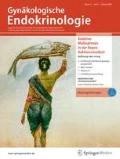Literatur
Azziz R, Marin C, Hoq L, Badamgarav E, Song P (2005) Health care-related economic burden of the polycystic ovary syndrome during the reproductive life span. J Clin Endocrinol Metab 90(8):4650–4658
The Rotterdam ESHRE/ASRM‐sponsored PCOS consensus workshop group (2004) Revised 2003 consensus on diagnostic criteria and long-term health risks related to polycystic ovary syndrome (PCOS). Hum Reprod 19:41–47
Panda PK, Rane R, Ravichandran R, Singh S, Panchal H (2016) Genetics of PCOS: A systematic bioinformatics approach to unveil the proteins responsible for PCOS. Genom Data 8:52–60
Minooee S et al (2018) Predicition of age at menopause in women with polycystic ovarian syndrome. Climacteric 21(1):29–34
Yin O et al (2018) Association between polycystic ovary syndrome and hot flash presentation during the midlife period. Menopause 25(6):691–696. https://doi.org/10.1097/GME.0000000000001055
Jaliseh K et al (2017) Polycystic ovary syndrome is a risk factor for diabetes and prediabetes in middle-aged but not elderly women: a long-term population-based follow-up study. Fertil Steril 108:1078–1084
Mumusoglu S et al (2018) Metabolic syndrome during menopause. Curr Vasc Pharmacol. https://doi.org/10.2174/1570161116666180904094149
Harris HR, Titus LJ, Cramer DW, Terry KL (2017) Long and irregular menstrual cycles, polycystic ovary syndrome, and ovarian cancer risk in a population-based case-control study. Int J Cancer 140(2):285–291
Barry JA, Azizia MA, Hardiman PJ (2014) Risk of endometrial, ovarian and breast cancer in women with polycystic ovary syndrome: a systematic review and meta-analysis. Hum Reprod Update 20(5):748–758
Author information
Authors and Affiliations
Corresponding author
Ethics declarations
Interessenkonflikt
A. Bachmann gibt an, dass kein Interessenkonflikt besteht.
Für diesen Beitrag wurden von der Autorin keine Studien an Menschen oder Tieren durchgeführt. Für die aufgeführten Studien gelten die jeweils dort angegebenen ethischen Richtlinien.
Additional information
Redaktion
L. Kiesel, Münster
A.O. Mueck, Tübingen
P. Stute, Bern
Rights and permissions
About this article
Cite this article
Bachmann, A. Management des Syndroms polyzystischer Ovarien in der Peri- und Postmenopause. Gynäkologische Endokrinologie 17, 288–290 (2019). https://doi.org/10.1007/s10304-019-00272-3
Published:
Issue Date:
DOI: https://doi.org/10.1007/s10304-019-00272-3

